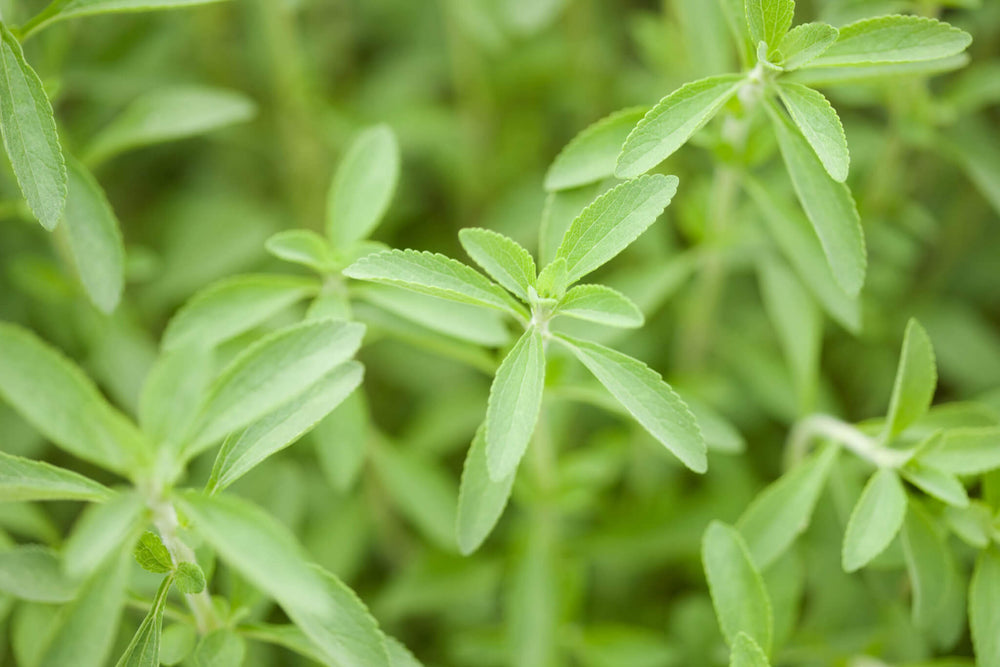Although stevia (Stevia rebaudiana) looks like an average green plant, it is an exciting choice for the herb garden because of the natural, calorie-free sweetness found in its leaves. Appreciated by diabetics and dieters, stevia is a tender perennial that loves the warm sun and dies back in a freeze. However, in zones 9 and warmer, the roots usually survive the winter and will come back in the spring. It can overwinter in zone 8, too, with protection. Gardeners in frost-free areas enjoy growing stevia year-round, allowing it to grow into a small shrub. However, vigor declines after the second year, so if you want to harvest the maximum amount of foliage, it pays to replant.
If you garden in containers, give your stevia plant at least a 12-inch pot with a quality potting mix. Place it in full sun, and water whenever the top inch of potting soil feels dry.
Quick Guide to Growing Stevia
- Plant stevia in spring once all chances of frost have passed. This sweet, low-calorie herb grows well in-ground but is also a splendid container plant.
- Space stevia plants 18 inches apart or plant them in 12-inch containers.
- Grow this sun-loving plant in an area that gets plenty of light and has rich, well-drained soil with a pH of 6.7 to 7.2.
- Feed regularly with a water-soluble plant food to promote healthy leaf production.
- Water once the top inch of soil becomes dry, but don't let the soil become soggy.
- Harvest stevia leaves once they're large enough to use.
Soil, Planting, and Care
Plant your stevia so that it has about 18 inches of room to call its own. In the loose, loamy, well-drained soil that the plant prefers, it will grow 1 to 3 feet in height, depending on the length of your growing season. Wait until after all danger of frost has passed before planting. Improve the existing soil by mixing in Miracle-Gro® Performance Organics® All Purpose In-Ground Soil, or plant in pots filled with Miracle-Gro® Performance Organics® All Purpose Container Mix. Both are enriched with aged compost and provide an excellent foundation for plant roots. For best growth, in addition to planting in great soil, feed stevia regularly with Miracle-Gro® Performance Organics® Edibles Plant Nutrition as directed on the label. Mulch to prevent the plant from drying out on hot summer days. Container-grown plants will benefit from the same plant food and mulch.
Troubleshooting
Stevia doesn't like soggy soil, so make sure that it has good drainage, or the roots could rot. A sure sign of rot is wilting from which the plant doesn't recover after watering. Fortunately, few insects bother stevia plants.
Harvest and Storage
Leaves are sweetest in the cool temperatures of autumn. They also taste best prior to the plant blooming.
To preserve summer's plenty and to make stevia convenient to use, dry it. Cut whole stems and then strip the leaves and tender stem tips. Place these on loosely woven fabric or non-metal screening outdoors on a dry, sunny day. One day should be long enough to dry the leaves; be sure to bring them in before the dew dampens them again. You can also use a food dehydrator if you have one. Once the leaves are crisp, crush them by hand or powder them with a food processor. Store in an airtight container. While the powdered leaves will not dissolve, they are a wonderful way to sweeten your beverages and foods.
Uses
Use the fresh leaves during the growing season to sweeten tea. The sweetness in the leaves is approximately one-fourth as concentrated as the white, powdered stevia sold at the store.
When sweetening with powdered leaves, use about 1/8 teaspoon of dried stevia to equal the sweetness of 1 teaspoon of sugar. Remember, while stevia will withstand the heat of cooking, it will not caramelize like sugar or feed yeast for breads.


FAQs
I tried packets of stevia from the grocery store. Do the fresh leaves taste better?
The fresh leaves of stevia are not as intensely sweet as the concentrated version sold at the store. Consequently, it is more difficult to overdo it, leaving food with a bitter taste. Many people seem to like fresh stevia (or the powdered dried leaves) better than the concentrate, but you should try it for yourself.
Can I simply put a leaf of stevia into my glass of tea to sweeten it?
Actually, you need to steep your tea with fresh stevia leaves. Heat releases the sweetness. If you use an instant tea or like to sweeten lemonade, make an extract by chopping about a cup of fresh leaves and pouring warm water over them. Let them steep overnight. Then strain and refrigerate. Your extract can be used to sweeten tea, coffee, fruit drinks, chopped fruit, and desserts. It will last about a month in the refrigerator - if you don't use it all first.
Where did stevia come from?
For hundreds of years, stevia has been a staple of the indigenous people of Paraguay, where it is native. Early settlers began to use it, and it came to be known as yerba dulce, which is "sweet herb" in Spanish. It is widely used in Japan in lieu of artificial sweeteners. For many people, it is healthier than sugar because it has little impact on blood glucose levels.
How many plants do I need for a family of four?
That depends on how much your family uses and whether you plan to dry it for use during the winter. For sweetening an occasional pitcher of iced tea, 1 plant should be enough. However, you may want as many as 6 if you plan to cut and dry the leaves. Even then, you won't need as much powdered stevia as you would sugar. For example, 1/8 teaspoon powdered, dried stevia is equivalent to 1 teaspoon of granulated sugar.




 Herbs
Herbs
 Vegetables
Vegetables
 Fruit
Fruit
 Flowers
Flowers
 Succulents
Succulents


